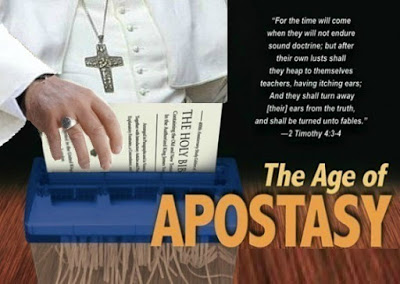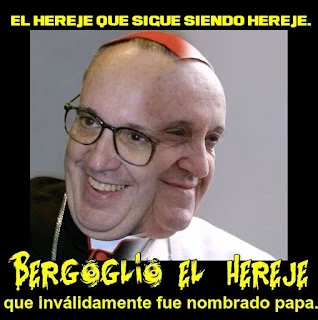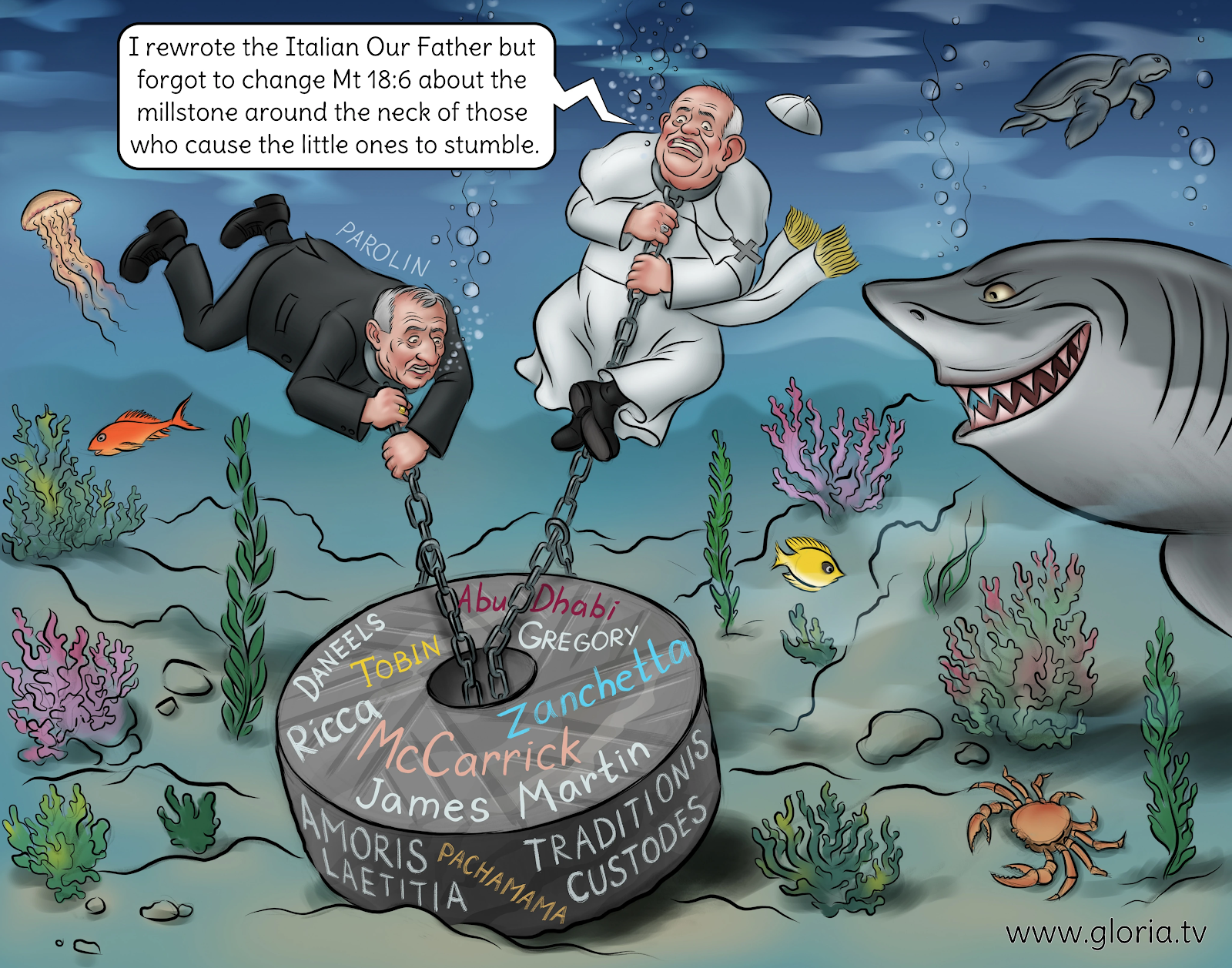There’s no such thing as ‘synodal’ theology in Catholicism
(LifeSiteNews) — New statutes imposed on the “Pontifical Academy of Theology” earlier this month call for “theology in a synodal form.” This new theology, as LifeSiteNews has previously reported, is incompatible with the Catholic understanding of theology as the study of truths revealed by God.
The “synodal form” of theology no longer looks to the infallible magisterium of the Catholic Church as its source and authoritative guide but rather to “the ability to listen, dialogue, discern and integrate the multiplicity and variety of instances and inputs.”
The letter introducing the statutes called for a “‘courageous cultural revolution’ (Encyclical Letter Laudato si‘, 114) that commits it, first and foremost, to be a fundamentally contextual theology, capable of reading and interpreting the Gospel in the conditions in which men and women daily live, in different geographical, social and cultural environments.”
In other words, the focus of theology is to change from God and His revelation to human experience in all its varied forms.
Indeed, the opening words of the letter state:
Promoting theology in the future cannot be limited to abstractly re-proposing formulas and schemes from the past.
Yet this is directly contrary to the very purpose of the teaching authority of the Catholic Church, which is precisely to re-propose to each new generation the one unchanging divine revelation which was entrusted to the apostles.
The enemies of the Church have long worked to break apart the theological science in order to undermine the secure transmission of the deposit of faith, as Pope St. Pius X noted in his 1907 encyclical Pascendi on the heresy of modernism:
For scholastic philosophy and theology they have only ridicule and contempt. Whether it is ignorance or fear, or both, that inspires this conduct in them, certain it is that the passion for novelty is always united in them with hatred of scholasticism, and there is no surer sign that a man is on the way to Modernism than when he begins to show his dislike for this system. Modernists and their admirers should remember the proposition condemned by Pius IX: ’The method and principles which have served the doctors of scholasticism when treating of theology no longer correspond with the exigencies of our time or the progress of science.’
Again, in his 1950 encyclical letter Humani Generis, Pope Pius XII warned against this trend:
[T]o neglect, or to reject, or to devalue so many and such great resources which have been conceived, expressed and perfected so often by the age-old work of men endowed with no common talent and holiness, working under the vigilant supervision of the holy magisterium and with the light and leadership of the Holy Ghost in order to state the truths of the faith ever more accurately, to do this so that these things may be replaced by conjectural notions and by some formless and unstable tenets of a new philosophy, tenets which, like the flowers of the field, are in existence today and die tomorrow; this is supreme imprudence and something that would make dogma itself a reed shaken by the wind.
And he foresaw that:
[T]hese advocates of novelty easily pass from despising scholastic theology to the neglect of and even contempt for the Teaching Authority of the Church itself.
The “synodal form” of theology is the continuation of a century old effort to eliminate the dogmas of the faith from the minds of those who would be faithful to Christ. The goal is to replace them with a new religion based on human experience. As Pius X said of the original Modernists:
If you ask on what foundation this assertion of the Believer rests, they answer: in the experience of the individual.
Theology is not ‘synodal,’ it is ‘positive’ or ‘scholastic’
The true understanding of theology as “the science about God and about divine realities” has been explained in a previous article.
This science takes as its foundational data the truths proposed for our belief by the magisterium of the Catholic Church or, where the Church has yet to make a pronouncement on a question, it is the task of theology to investigate what is true by studying the sources of revelation, namely Scripture and Tradition. The Church has developed many different ways of studying the deposit of faith, in order to understand it more deeply.
In the sixteenth century, as today, distorted forms of theology spread through the Church, severing entire peoples and nations from her mystical body. The Protestants of the sixteenth century, as the Modernists of our own time, reserved particular hatred for the scientific method of Catholic scholastic theology.
In the midst of the counter-reformation, St. Ignatius Loyola, in his Spiritual Exercises, established eighteen rules for having the true sentiments of the Church. The eleventh rules reads:
To praise positive and scholastic learning. Because, as it is more proper to the Positive Doctors, as St. Jerome, St. Augustine and St. Gregory, etc., to move the heart to love and serve God our Lord in everything; so it is more proper to the Scholastics, as St. Thomas, St. Bonaventure, and to the Master of the Sentences, etc., to define or explain for our times the things necessary for eternal salvation; and to combat and explain better all errors and all fallacies.
Positive and scholastic theology are the two wings of Catholic theology, whereby the intellect rises to the contemplation of divine things.
The theologian Monsignor Gerard Van Noort describes positive theology as follows:
Positive theology accurately demonstrates the existence of the various truths of the faith by collecting and organizing the various statements of Sacred Scripture and the documents of Tradition. Its task is to show that such and such a truth really is contained in revelation. Positive theology, then, takes its name from the fact that its very method leads it to be almost exclusively concerned with the valid demonstration of the actual existence of such and such a revealed truth.
By positive theology the revealed truth is expounded to the Catholic faithful and defended against the assaults of heresy. Positive theology flourished in the first centuries of the Church, when the Church was engaged in intensive missionary activity and at the same time opposing the constant upsurge of heresies. This form of theology also took on renewed importance during the counter-Reformation when it was needed to defend Catholic truth against Protestant errors.
Examples of great theologians who practiced positive theology are Church Fathers like St. Augustine, St. Athanasius, St. Basil, and St. Ambrose. St Robert Bellarmine is an excellent representative of later theologians who used a positive method, which he integrated with the scholastic theology of the intervening centuries.
Positive theology today is generally divided into:
- Biblical theology if it bases its arguments mainly on Sacred Scripture
- Patristic theology if it bases its arguments mainly on the Fathers of the Church
- Credal theology if it bases its arguments mainly on creeds, councils and other official documents of the Church
- Polemical theology when its purpose is to defend Catholic doctrine from attack.
Scholastic theology came into its own in the High Middle Ages when European society was almost wholly Christian, and heresy was generally less of a pressing problem (though heresies of course existed). In this environment, theologians were able to give more focus to examining the doctrines of the faith and the connections between them.
As Van Noort explains, this method of theology makes great use of the science of philosophy for the following purposes:
- To offer a deeper and fuller understanding of the meaning of religious dogmas;
- To harmonize dogmas with the principles of natural reason;
- To illustrate dogmas by analogies drawn from the world around us;
- To make clear the bonds of union existing between the various dogmas and between the dogmas themselves and natural truths;
- To deduce various conclusions from the dogmas;
- To organize all sacred doctrine into one harmonious system.
He summarizes the end of scholastic theology as follows: “To sum up, it seeks to draw out some understanding of God’s revealed truth, by investigating, as far as the frailty of human intelligence permits, precisely what a given thing is and why it is so.”
As indicated above, scholastic theology makes great use of the science of philosophy to assist its work of systemizing and deepening our understanding of the revealed doctrine. The philosopher whose writings have had the greatest influence on its development is Aristotle (384-322 BC).
St. Anselm of Canterbury (c.1033-1109) is often considered to be the first of the scholastic theologians. The greatest of all is St. Thomas Aquinas (c.1224-74). Scholastic theology was at its height from the twelfth to the sixteenth century. Scholastic theology flourished again during the late nineteenth and early twentieth century due to the leadership of Pope Leo XIII, particularly as a result of his 1879 encyclical letter Aeterni Patris.
Following Vatican II, the practice of scholastic theology was largely extinguished in once Catholic institutions, but many of the works produced in the first half of the twentieth century remain highly accessible to readers today.
Positive and scholastic theology are complementary to each other. Theologian Michaele Nicolau expresses this beautifully when he writes:
Positive theology is said to be the intellect seeking faith; that is, reason seeks what the sources of revelation and faith contain. But scholastic theology is called faith seeking understanding; it is that which St. Augustine eagerly sought: ‘I wanted to see with my intellect what I believed,’ and St. Anselm: ‘I am not attempting, Lord, to penetrate your majesty, because in no way do I compare my intellect to it, but I desire in some way to understand your truth, which my heart believes and loves. For I am not seeking to understand in order to believe, but I believe in order to understand.’
What both have in common is that they are directed towards the God who reveals His unchanging truth to the Catholic Church. And therefore, they are the antidote for the false “synodal form” of theology by which the successors of the original Modernists seek to turn the hearts of man from the truth of God.
Yet the great works of theology stand open to us today, with something for every level of understanding and education. Let us return to them and find nourishment for our souls in the one unchanging deposit of faith.







No comments:
Post a Comment
Note: Only a member of this blog may post a comment.